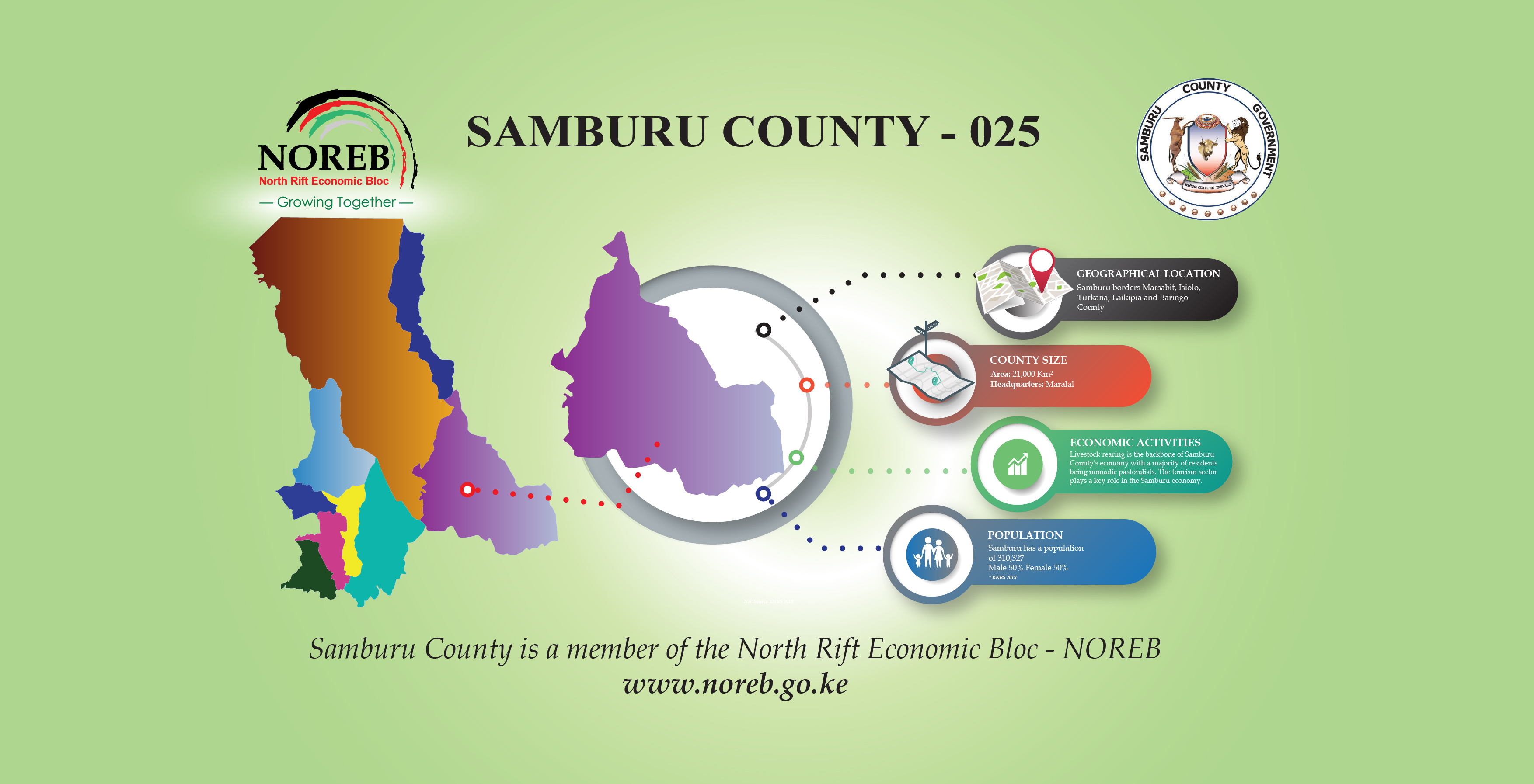
SAMBURU COUNTY
Samburu County has a local steppe climate. This means that during the year there is little rainfall of about 36mm to 279mm. The average low temperature in July is 16C and the highest temperature in February at 32C.
Samburu shares its borders with four other counties; Marsabit, to the North and North East, Isiolo to the East, Turkana to the West and Northwest, and Laikipia and Baringo to the Southwest. The Samburu people are closely related to the Maasai who mainly occupy the County. The Samburu rely on cattle as their source of livelihood. Their main food consists of Maize, milk and blood a delicacy that the Maasai people enjoy. Other ethnic groups living in Samburu County include Rendile, Turkana and Borana. They rear cattle, donkeys, camels and goats.
Destination Samburu
Samburu County is a paradise for travellers seeking fun, adventure, unique cultural experience or just pure solitude off the beaten tracks and the fast lanes of urbanization. The nerve centre of wildlife conservation and tourism in the North Rift region is Samburu National Reserve. It is home to herds of elephants incredibly pleasant to watch, especially when they converge at the UasoNg’iro River in the late mornings to drink, bathe and play. The Reserve teems with other species of herbivores such as Impala, Grant’s Gazelle, the endangered Grevy’s Zebra, the long-necked Waller’s Gazelle (Gerenuk), Reticulated Giraffe, Beisa Oryx and the ubiquitous Kirk’s and Guenther’s Dik-Dik among others. Lions, Leopards, Cheetahs, the Nile crocodiles, Spotted and Striped Hyenas and African Wild Dogs are the top predators in the Reserve. At over three hundred species, Birdlife at the park is amazing. All animal species in the Reserve are free ranging and therefore roam freely in and out of the Reserve.
The Samburu people have traditionally been wildlife conservationists. They have now combined their traditional conservation practices and modern ones to guarantee the survival of species on their land. Through establishment of community wildlife conservancies, communities have widened the space available for wildlife and guaranteed their safety. In return, they have engaged in wildlife based tourism ventures that have brought them direct monetary and other benefits that they can associate with their direct involvement in wildlife conservation.
Namunyak Wildlife Conservancy is the oldest and boasts three high-end tourism camps; The Sarara Camp, The Sarara Tree House and The Kitich Camp. The conservancy also hosts the Reteti Elephant Sanctuary which rescues distressed baby elephants, rehabilitates them and finally resends them out to live normal lives in the wild. Sera Community Wildlife Conservancy is home to the only community run Black Rhino Sanctuary in Africa. Covering an area of 107km², the Sanctuary is now home to 16 Black Rhinos after an initial introduction of 10 in 2015.
Visitors to the Sanctuary can commute from Samburu National Reserve and other community conservancies for day excursions to track the rhinos or stay in the Kauro Bandas just outside the Sanctuary. Bordering Samburu National Reserve are Kalama and Westgate Community Wildlife Conservancies which host Samburu Saruni Camp and Sasaab Lodge respectively.
Running for 150km from south to north from Samburu East Sub-County to Samburu North Sub-County, the 40km wide Matthews Range of mountains is a sky island with an incredible variety of both flora and fauna. Cycads, an ancient plant species whose existence dates back to the time that Dinosaurs roamed the planet are a common feature of these mountains. The tops and slopes of this mountain range on which Sarara Camp, Sarara Tree House and Kitich Camp are nestled provide sweeping panoramic views of valleys and the arid scrublands below. Mountain hiking to the highest peak, Warges (8819 feet above sea level) and other peaks such as Lolokwe Mountain (6440 feet above sea level) is an enchanting tourism activity. Loololokwe Mountain with its magnificent rock face is a paragliders, air divers and rock climbers’ favourite.
The Samburu people have over the years stuck tenaciously to their culture and are among the most culturally rich of Kenyan communities today. Their daily life activities are as fascinating as are their elaborate cultural ceremonies. Cultural immersion adventures therefore never disappoint.
Samburu National Reserve hosts 6 camps and 3 lodges. The Reserve is a 5 hour drive from Nairobi on the Great North Road or a 45 minute flight. All community wildlife conservancies have airstrips, so they are accessible both by road and air. Samburu Intrepids is one of the tented camps in the Reserve. It has 28 modern luxury tents that sit on raised decks overlooking the Uaso-Ng’iro River. The camp’s swimming pool is a popular spot that attracts guests to cool off as much as the river attracts elephants to do the same. A unique feature about this camp is that it runs The Adventurers Club – a children’s programme that both entertains and educates guest children as their parents enjoy their time without the slightest worry about their children. The Camp naturalist gives educative talks to guests every evening on the wildlife and general ecology of Samburu and about the culture of the host community, the Samburu.
Shaba National Reserve located in the South boasts of a huge population of wildlife and over 350 bird species. Maralal National Reserve situated in the heart of Samburu is an ideal destination for wildlife Safari. Other facilities in the region include Samburu Elephant Camp, Samburu Kitich Camp, Samburu Larsens Tented Camp and Samburu Bedouin Camp.
